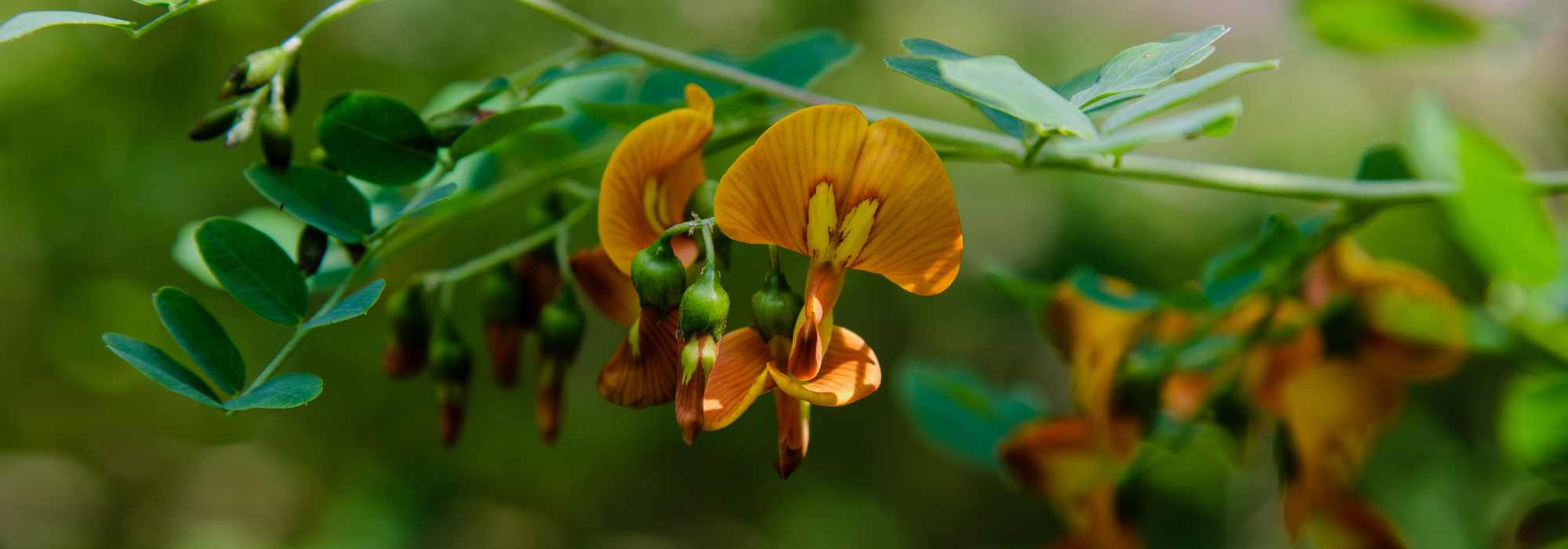
Cancer blush - Colutea: planting, pruning and care
Contents
The Cancer bush in a few words
- The Cancer bush is perfect for dry and sunny gardens.
- Its summer flowering attracts pollinators and brightens the garden.
- Later, the “bladder fruits” are decorative, translucent (and fun) pods.
- The deciduous foliage is a beautiful soft green.
- Hardy and easy: the Colutea is drought-resistant and requires minimal maintenance.
The word from our expert
The Colutea arborescens, better known as the bladder senna, is a bush full of charm and character, ideal for gardens seeking a natural and simple aesthetic. Native to Mediterranean regions, it stands out with its bushy and graceful silhouette, as well as its ability to thrive in poor, rocky, and well-drained soil, where other plants might struggle. It is a perfect companion for dry and sunny gardens, offering both resilience and delicacy.
In summer, the bladder senna adorns itself with yellow flowers, sometimes tinged with orange, small yet radiant, forming elegant clusters that attract pollinators. Its delicately papilionaceous flowers are followed by lightweight pods shaped like small translucent bladders, which, as they ripen, take on reddish hues. These highly characteristic, almost ephemeral fruits dry out and become slightly brittle, earning them the poetic nickname “love bladders.” Children and adults alike often enjoy popping them for the sheer pleasure of their texture and lightness.
The foliage of the bladder senna is a tender green and slightly velvety. It is deciduous, disappearing in winter to leave the bush naked, but this only highlights the vibrant arrival of spring. Its open structure and rounded shape make it easy to integrate this plant into compositions alongside lavenders, santolinas, or cistus, creating harmonious and distinctly Mediterranean ensembles.
Hardy and undemanding, the bladder senna is a top choice for gardeners seeking authenticity and simplicity. Once well-established, it requires minimal maintenance. A light pruning at the end of winter is enough to encourage generous flowering and a denser habit, while its robust root system makes it particularly resistant to drought.
The bladder senna is, in short, a bush that embodies beauty without artifice. It knows how to brighten the most arid landscapes with its golden flowers and unique fruits, offering the garden a quiet and wild radiance, like an echo of Mediterranean nature in all its splendour.
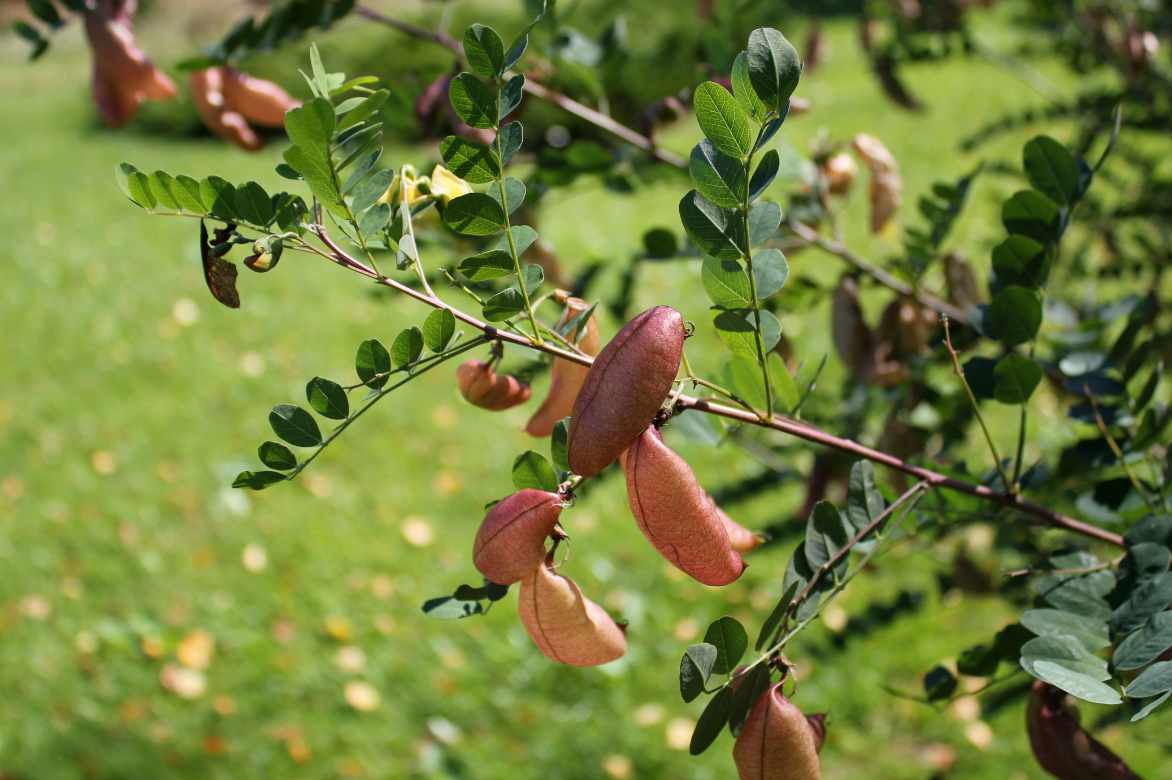
Colutea arborescens
Botany and description
Botanical data
- Latin name Colutea sp.
- Family Fabaceae
- Common name Bladder senna, Bladder tree
- Flowering May to August
- Height 2 m
- Sun exposure sun
- Soil type dry, very well-drained, even poor
- Hardiness -20°C
Colutea, also known as bladder senna or bladder tree, is a genus of plants belonging to the Fabaceae family. Its name comes from the ancient Greek “kolutea”, which evokes the idea of hollow wood, in reference to its fruits: small, inflated, translucent pods that, when dried, resemble small bladders. This genus includes around 25 species, among which the Colutea arborescens, or common bladder senna, is the most widespread for its hardiness and characteristic fruits. The Colutea orientalis is also appreciated, particularly for its colourful flowering and more compact form.
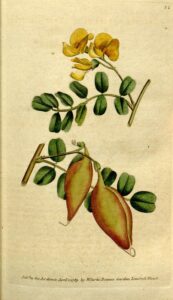
Colutea arborescens : botanical plate circa 1790
These bushes are particularly well-suited to dry and sunny environments. They are naturally found in Mediterranean regions, from southern Europe to the Middle East and Central Asia. They thrive in calcareous, poor, and well-drained soils and are highly drought-resistant, making them perfect candidates for dry gardens.
Did You Know? The name “bladder senna” comes from the old French verb baguenauder, meaning “to amuse oneself with trifles” or “to wander aimlessly”. This term was given to Colutea because of its fruits, which resemble small inflated bladders, light and fun to pop between fingers, like a child’s game. Indeed, the light and translucent pods, which almost float in the air, are seen as a symbol of lightness, evoking simplicity and carefreeness.
Bladder senna is a bush distinguished by its bushy and airy appearance, reaching between 2 and 3 metres in height. Its habit is naturally spreading, with flexible and arched branches that give it an elegant, albeit slightly untidy, silhouette. This form makes it a beautiful bush for natural or Mediterranean-style gardens.
Its root system is taprooted and powerful. The plant can thus anchor itself well in poor and stony soils and withstand periods of drought. It is a hardy plant, capable of drawing water from deep underground, making it a good candidate for dry gardens and arid terrains.
The foliage of Colutea is deciduous, composed of pinnate leaves of a lovely soft green. Each leaf consists of small oval and rounded leaflets, slightly velvety to the touch. This light foliage creates an impression of softness and complements its flexible habit.
The inflorescence of Colutea consists of clusters of papilionaceous flowers, typical of the Fabaceae family. The flowers are generally yellow, sometimes tinged with orange or red depending on the variety. They appear all summer and attract pollinating insects, such as bees and butterflies, thus contributing to local biodiversity.
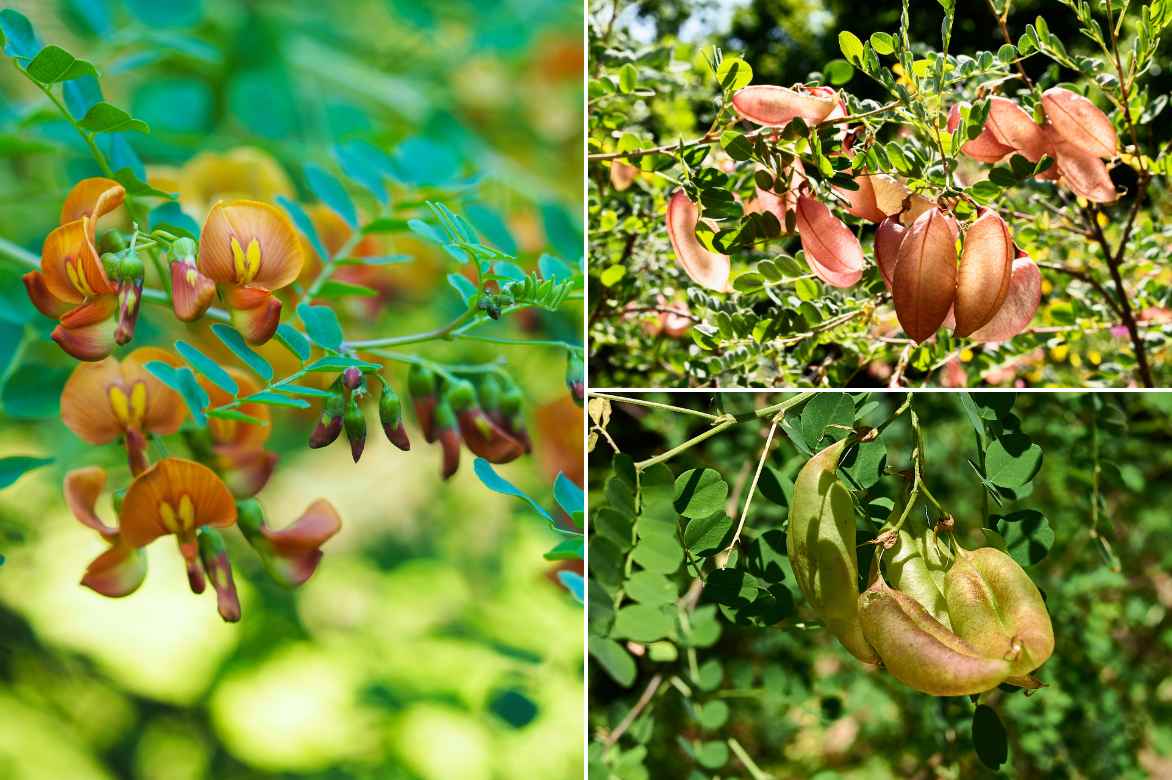
A graceful flowering and light foliage, and very original coppery fruits
Finally, fruiting is one of the most striking characteristics of Colutea. After flowering, the bush produces inflated pods, shaped like small translucent and hollow bladders, which take on a reddish hue as they ripen. These fruits, filled with air, are light and often popped by children. They remain on the plant in autumn, adding a decorative touch even after the leaves have fallen. These bladder-shaped pods, which ripen in late summer, also provide temporary shelter for certain insects, creating natural “hideouts” where they can protect themselves from bad weather or predators.
The bushy growth and flexible habit of bladder senna make it perfect for creating informal hedges, where it can integrate without the need for strict pruning. It also finds its place in naturalistic borders, where its light foliage and yellow summer flowers brighten plantings. Bladder senna integrates particularly well into the edges of dry gardens, alongside other drought-resistant plants. In borders, it acts as a beautiful, resilient, and elegant screen, harmonising with Mediterranean or wild styles thanks to its hardiness and ease of maintenance.
The most beautiful varieties
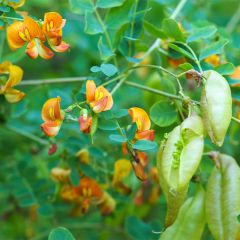
Colutea arborescens
- Période de floraison June to August
- Hauteur 2 m
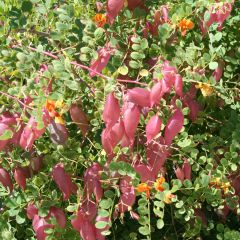
Colutea media Copper Beauty
- Période de floraison June to October
- Hauteur 1,75 m
Planting the Bladder Senna
Where to Plant?
To plant a bladder senna, choose a sunny location with well-drained soil, preferably chalky or stony, as it does not tolerate waterlogged conditions. This bush is ideal for dry or rocky gardens and can withstand poor soils and drought conditions once established.
Colutea struggles with heavy, poorly drained soils, which retain water and increase the risk of root rot, a common issue for plants adapted to dry environments. If your soil is clay-based, it is advisable to improve drainage before planting the bladder senna by adding compost, gravel at planting time, and/or planting on a mound.
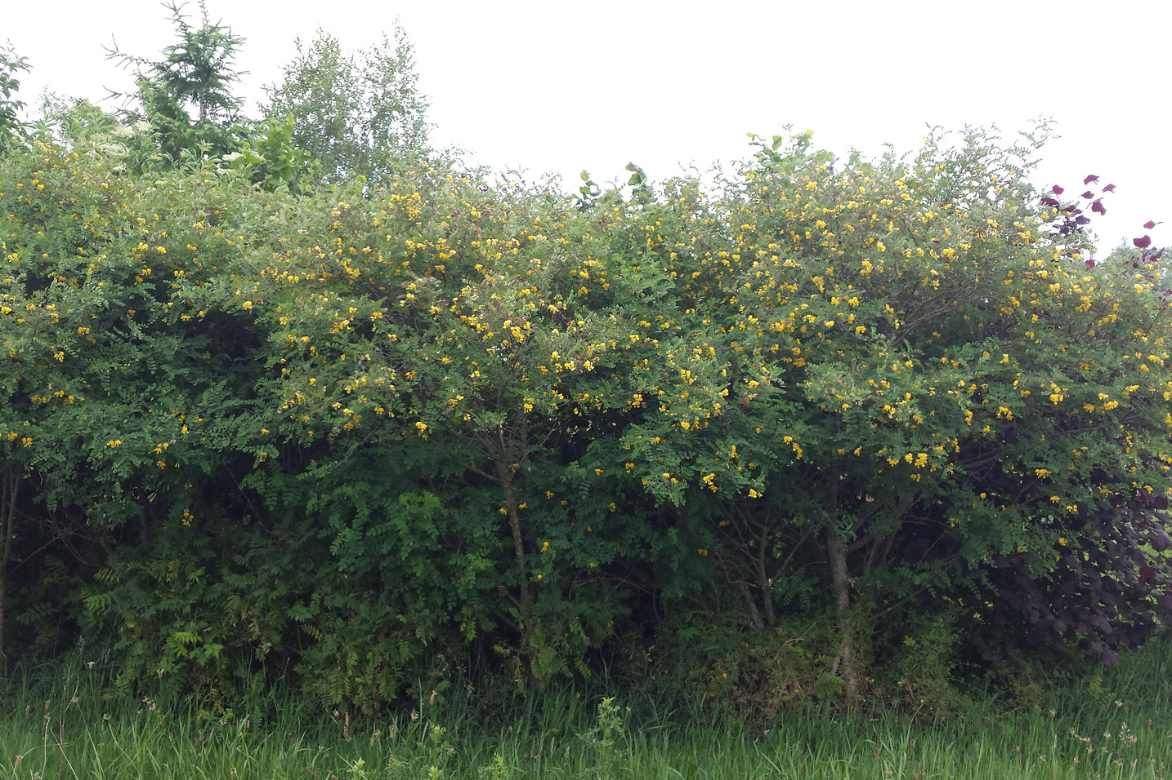
Colutea arborescens planted here as a wild hedge (©De Tuin-Flickr)
When to Plant?
The ideal time to plant is in autumn, between October and November, as this allows the roots to establish before spring. In regions with harsh winters, you can also plant in early spring, but be sure to water it regularly during the first few weeks to help its roots settle.
How to Plant?
- Dig a hole: make it about twice as wide as the plant’s root ball.
- Gently place the root ball into the hole, positioning it so the plant stands upright.
- Fill the space around the root ball with the original soil, lightly firming it as you go to secure the plant and avoid air pockets.
- Water generously immediately after planting to encourage rooting, even if the soil is dry or well-drained. This initial watering helps the plant get off to a good start.
- Once established, the bladder senna requires little maintenance. A light pruning each year, ideally in late winter, will suffice to encourage a more balanced habit and stimulate beautiful flowering the following spring.
Maintenance, pruning, and watering
Pruning
- When to prune?: Pruning is ideally carried out at the end of winter, before the start of new growth, usually in February or March.
- How to prune?: Perform light pruning to maintain a balanced habit and encourage flowering. Remove dead, damaged, or overly old branches, and shorten shoots that disrupt the shape of the bush. If necessary, you can also cut back more severely every 2-3 years to rejuvenate the bush, cutting down to 20-30 cm from the soil; it will regrow vigorously.
Watering
During the first year after planting, water regularly to help the roots establish, especially during prolonged dry spells. However, once well-rooted, the Colutea tolerates drought very well and hardly requires watering, except during prolonged extreme heat.
You can add a mineral or organic mulch around the base to limit weed growth and retain some moisture, especially in the first year.
Fertilisation
In principle, no fertiliser is necessary. The Colutea thrives in poor soils, and too many nutrients could stimulate foliage growth at the expense of flowers.
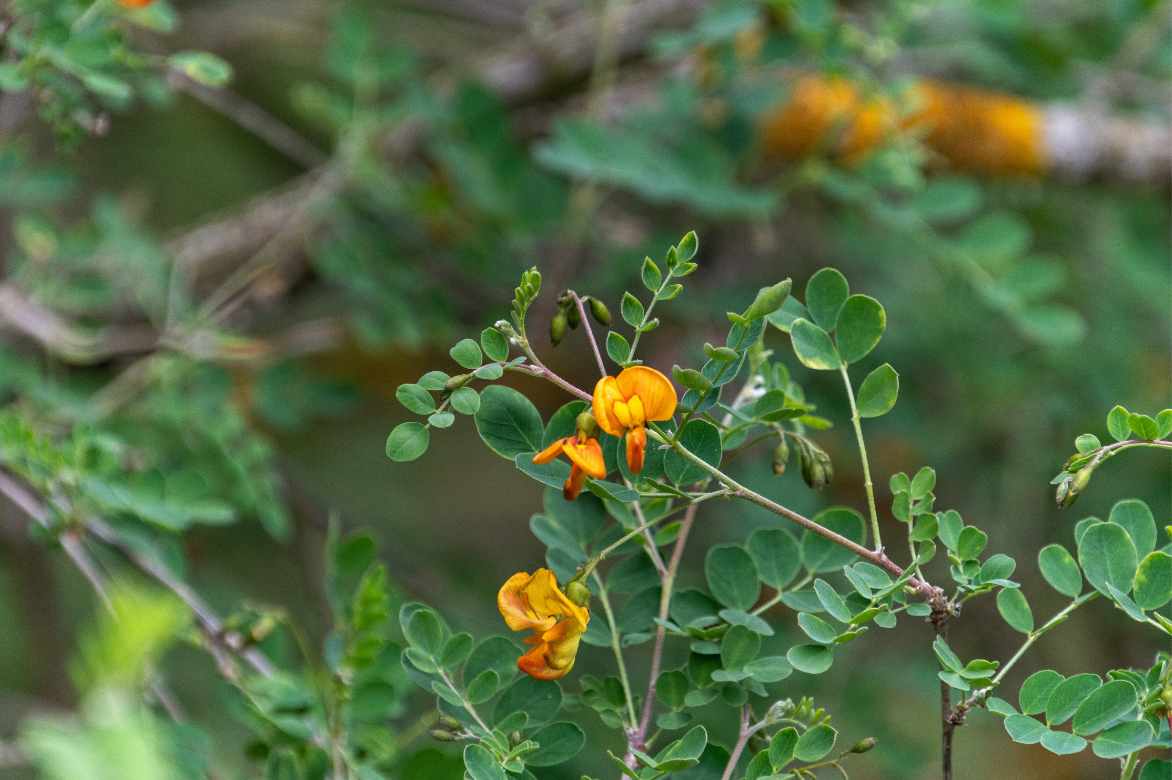
Colutea arborescens
Diseases and Pests
Colutea is a particularly hardy and resilient plant, rarely affected by diseases or pests.
However, under unsuitable growing conditions, such as poorly drained soil or excessive moisture, it can be vulnerable to root rot, a fungal disease that affects the root system.
In exceptional cases, it may also attract aphids, though these rarely cause significant damage and can be easily controlled.
How to propagate the bladder senna?
Sowing
- Harvest the seeds from the pods at the end of summer or in autumn, once they are fully ripe. Shake the pods; if the seeds rattle inside, they’re ready.
- Let them dry for a few days, then store them in a dry place if you plan to sow them in spring.
- Sow the seeds in pots or directly in the ground in spring, after the last frost. For pots, use a mix of compost and sand for good drainage.
- Water lightly and keep the pots in a sunny spot. Germination takes about 2 to 4 weeks.
Propagation by Cuttings
- Take semi-hardwood cuttings in summer, around July or August.
- Cut sections of 10 to 15 cm and remove the leaves from the base.
- Plant the cuttings in a mix of compost and sand, keeping the substrate slightly moist.
- Place them in a bright spot, away from drafts. Roots should form within a few weeks.
And layering? Layering the bladder senna, though less common, is possible. In late spring, select a low and flexible stem, bury a portion of its length in the soil, and secure it with a stone or a clip. Keep the soil moist to encourage root formation. Once roots appear, separate the new shoot from the parent plant and replant it in the desired location.
Successful pairings
To create a harmonious border around the Colutea arborescens, the common bladder senna, choose plants that thrive in sunny, well-drained soil while offering a contrast in textures and colours. The Lavandula angustifolia ‘Munstead’, with its grey-green foliage and blue-violet flower spikes in summer, pairs beautifully with the yellow-orange flowers of the bladder senna, creating a soothing Mediterranean atmosphere. At the base of the Colutea, the compact, silvery Santolina ‘Edward Bowles’ adds structure while harmonising with its creamy-white summer flowering.
The Cistus obtusifolius, with its white flowers and yellow centres, brings a lightness that echoes the Colutea, and its evergreen foliage maintains visual interest in winter. The rosemary, with its dark green foliage dotted with tiny blue flowers, not only adds an aromatic dimension to the border but also forms a striking contrast with the Colutea. Alternatively, the Afghan sage, such as the Perovskia ‘Blue Steel’, with its violet-blue flowers and fine foliage, creates visual depth that accentuates the bright yellow of the bladder senna.
Finally, the Thymus praecox ‘Coccineus’, used as ground cover or edging, forms a lush, evergreen, and fragrant carpet that perfectly complements the soft, airy habit of the Colutea. Together, these plants create a natural, colourful ensemble, perfectly suited to drought conditions, for a garden that is both vibrant and easy to maintain in well-drained soil and full sun.
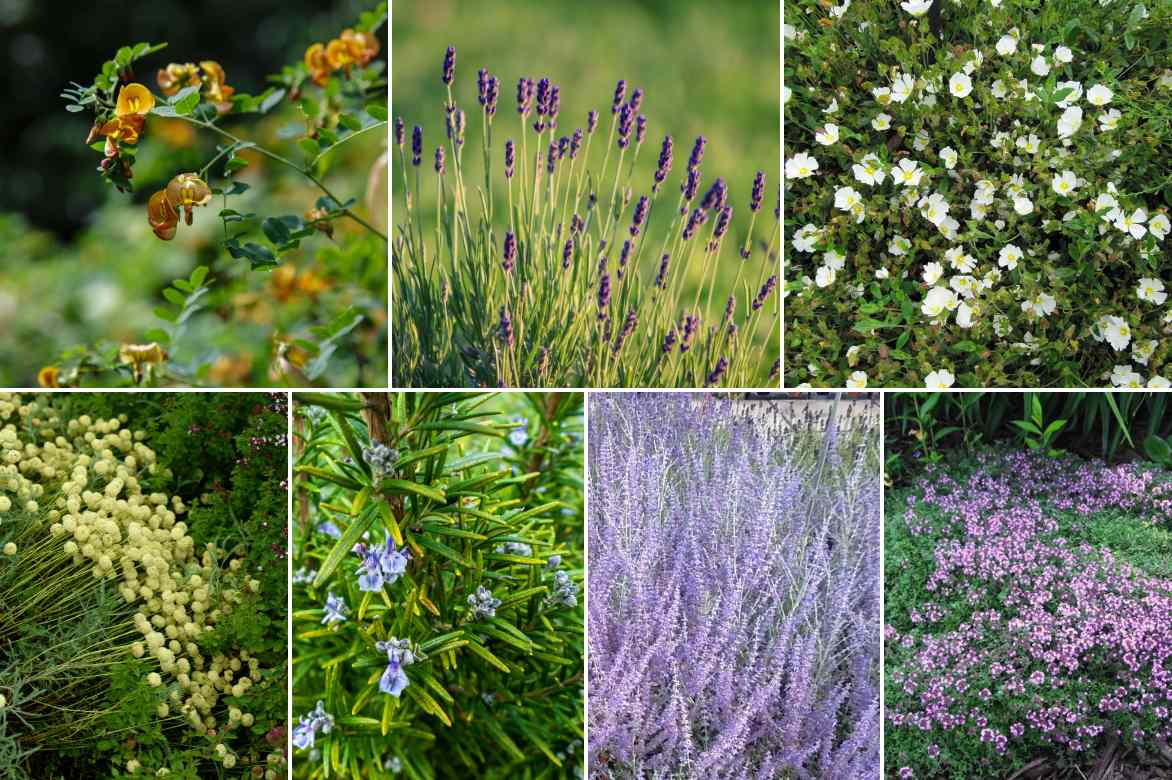
Colutea arborescens, Lavender ‘Munstead’, Cistus obtusifolius, Santolina ‘Edward Bowles’, rosemary, Perovskia ‘Blue Steel’, and creeping thyme ‘Coccineus’
Also worth reading...
→ Looking for an exotic touch in dry, sunny soil? Follow Gwenaelle’s expert advice in the guide “Creating a Dry Exotic Garden“.
→ There are plenty of drought-resistant bushes. Sophie introduces a few in her guide “Drought-Resistant Bushes“.
→ How to recreate a Mediterranean vibe in your garden? Read Alexandra’s guide “Mediterranean Garden: 10 Iconic Plants“.
- Subscribe!
- Contents
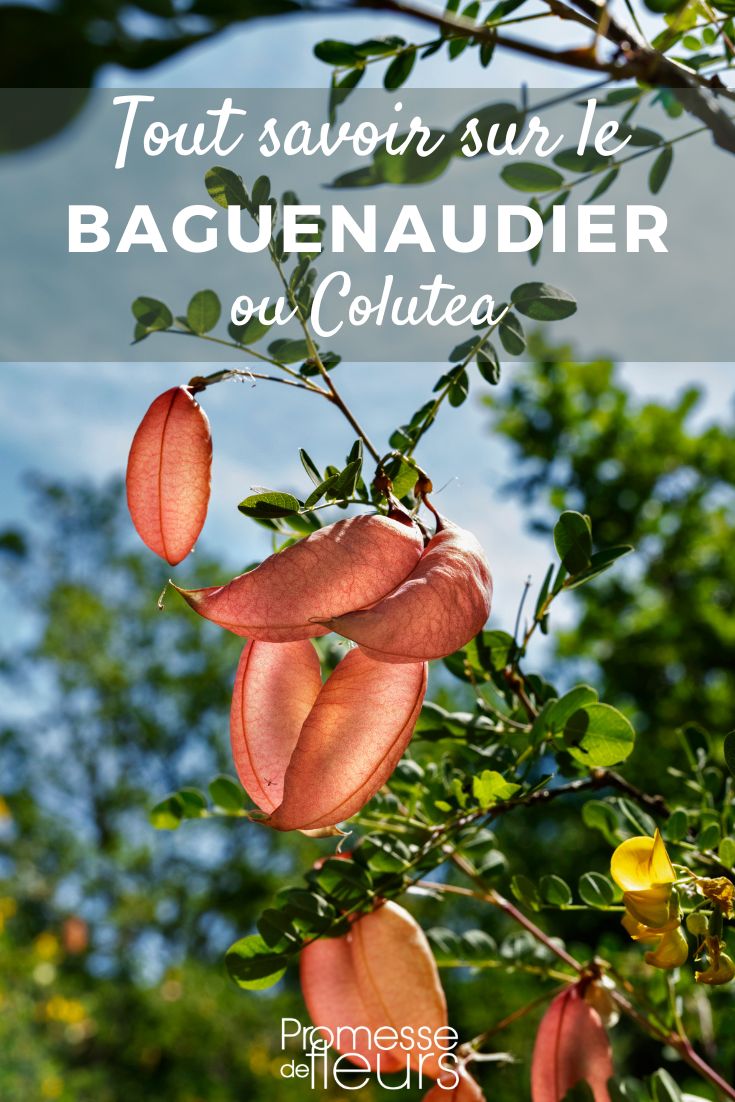































Comments